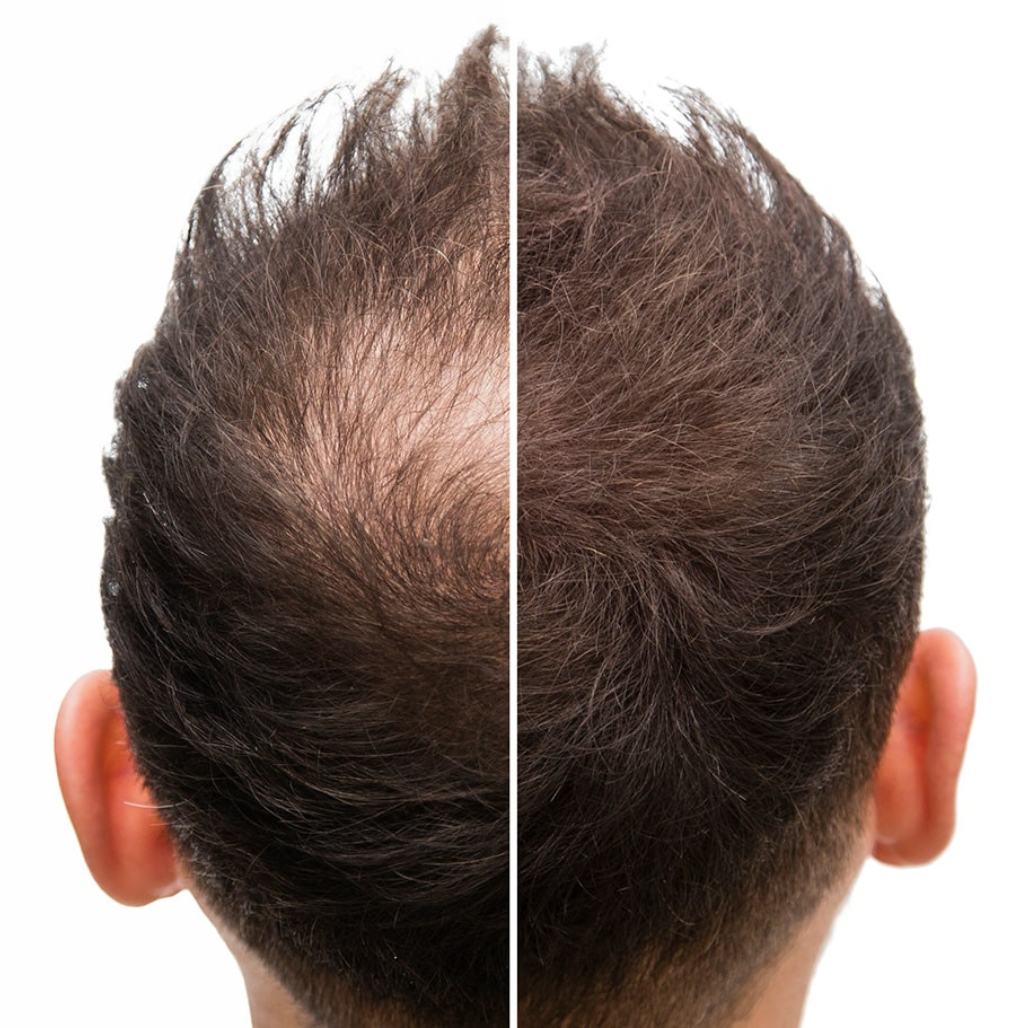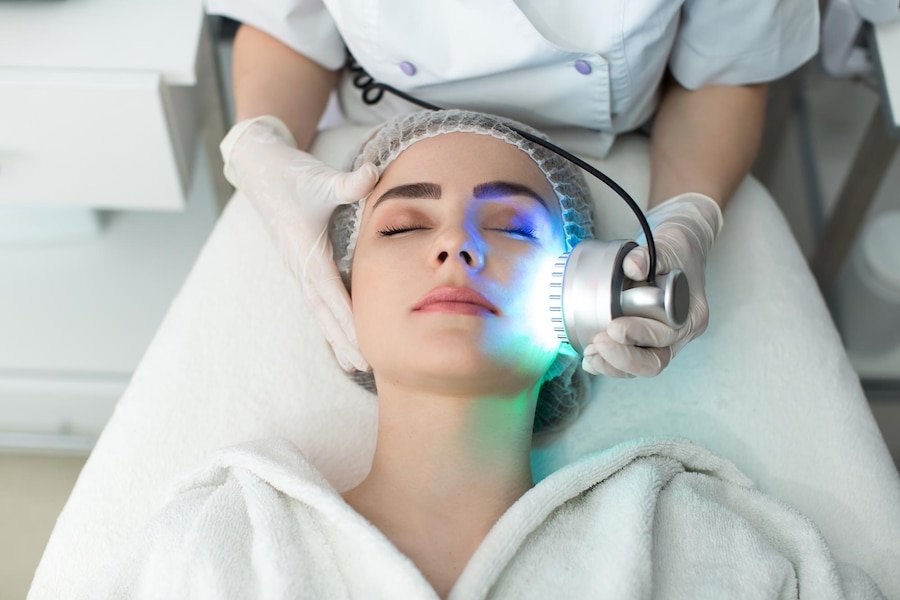PRP Hair Restoration Treament
Benefits of the Treatment:
- PRP uses your body’s own platelets, making it a safe and biocompatible treatment with minimal risk of side effects.
- Unlike surgical hair restoration methods, PRP is non-surgical and requires little to no downtime.
- PRP therapy can improve hair density and thickness, making it a popular choice for those in the early stages of hair loss.
- Most clients return to their regular activities on the same day, with only minor precautions for aftercare.
- In addition to promoting growth, PRP nourishes hair follicles, enhancing the overall health and resilience of your hair.
PRP Therapy involves a few simple steps that make a big impact:
- Blood Draw: A small amount of blood is drawn from your arm, similar to a routine blood test.
- Centrifugation: The blood sample is processed in a centrifuge to separate the platelet-rich plasma from other blood components. This concentrated PRP contains growth factors essential for stimulating hair follicles.
- Scalp Injection: The PRP is injected into areas of your scalp with thinning hair, where it promotes healing and natural hair growth.
Initial Consultation
During your first visit, our specialists will examine your hair and scalp to determine if PRP therapy is the right option for you. We’ll discuss your hair restoration goals and answer any questions you may have.Customized Treatment Plan
Based on your specific needs, we’ll create a personalized treatment plan that aligns with your hair regrowth goals. Most clients need 3-4 sessions, spaced a few weeks apart, for optimal results.Treatment Sessions
PRP treatments are quick and straightforward, typically lasting 30–45 minutes. A topical numbing cream may be applied for added comfort, and you’ll be able to resume normal activities right after your session.Follow-Up and Maintenance
After the initial series of treatments, many clients benefit from maintenance sessions every 6-12 months to continue stimulating hair growth and maintain results.
After completing your PRP treatment plan, you can expect:
- Thicker and Denser Hair: Noticeable improvement in hair volume and thickness over the following months.
- Enhanced Hair Health: PRP nourishes your follicles, promoting stronger, healthier hair.
- Natural-Looking Results: Because it uses your body’s own growth factors, PRP helps your hair grow naturally, blending seamlessly with existing hair.
PRP Hair Restoration offers a natural and lasting boost to hair growth, but maintenance can help prolong and maximize results. Here’s what you can expect in terms of longevity:
- Initial Results Timeline: After completing the initial series of PRP treatments (typically 3-4 sessions spaced about a month apart), you’ll begin seeing thicker, fuller hair growth over the next 2-3 months.
- Maintenance Treatments: To sustain and enhance results, maintenance sessions every 6-12 months are generally recommended. These follow-up treatments stimulate hair follicles and help you retain the density and volume achieved during the initial treatment phase.
- Factors Affecting Longevity: The duration of PRP results can vary based on individual factors, such as age, genetics, hair loss progression, and lifestyle. People who proactively maintain their hair health tend to experience longer-lasting effects.
With regular maintenance and a healthy hair care routine, many clients enjoy the benefits of PRP Hair Restoration for several years, effectively slowing down the progression of hair loss.
Does PRP hair treatment regrow hair permanently?
PRP hair treatment promotes hair growth by using your body’s own platelets to stimulate dormant hair follicles. However, it’s not a one-time, permanent fix for hair loss. While PRP can encourage natural regrowth and improve hair density, the effects generally last between 6 to 12 months. Hair loss is often a continuous process, especially if it’s due to genetic factors, so the benefits of PRP will gradually fade over time.
To maintain and enhance results, follow-up sessions are typically recommended every 6-12 months. These maintenance treatments help keep hair follicles active, prevent further thinning, and maintain the fuller look achieved during the initial PRP sessions.
For best results, many patients integrate PRP therapy into a broader hair care routine, which may include other treatments or medications based on a doctor’s recommendation.


Differences between PRP and PRF treatments for hair restoration?
PRP (Platelet-Rich Plasma) and PRF (Platelet-Rich Fibrin) are both hair restoration treatments that use your blood’s natural growth factors to stimulate hair regrowth.
PRP is prepared by spinning blood at high speeds to separate platelets, which are then injected into the scalp. It releases growth factors quickly, giving an immediate boost to hair follicles, though it may require regular maintenance every 6-12 months.
PRF, on the other hand, is prepared with a slower centrifugation process that preserves more growth factors, white blood cells, and a fibrin matrix, which creates a scaffold for a slow, sustained release of growth factors over several days. This longer-lasting release may make PRF more effective for hair regrowth, often requiring fewer maintenance sessions compared to PRP.
Book a consultation
Schedule a consultation call with our experienced practitioners today to discuss your options.
FAQs
PRP hair restoration is generally well-tolerated, with most patients experiencing only mild discomfort. A topical numbing cream is often applied before the treatment to minimize any pain from the injections. You may feel slight pressure or a mild pinch, but the discomfort is usually minimal and temporary.
While PRP is a natural treatment with few side effects, it does have some downsides. Results may vary from person to person, and it often takes multiple sessions to see noticeable improvements, which can be costly over time. Additionally, PRP is not a permanent solution for hair loss, and maintenance sessions are typically required every 6-12 months to sustain results. Some people may also experience minor bruising or swelling at the injection site.
Using PRP too frequently isn’t necessarily harmful, but it may be unnecessary and won’t accelerate results. PRP treatments should be spaced out appropriately, usually every 4-6 weeks initially, to allow the scalp to respond to each session. Overdoing PRP sessions could lead to irritation or discomfort without providing added benefits for hair growth.
One session of PRP is generally not enough for optimal hair restoration. Most patients require an initial series of 3-4 sessions, spaced about a month apart, to see visible improvements in hair density and thickness. After the initial series, maintenance treatments every 6-12 months are recommended to sustain results.
People with certain medical conditions should avoid PRP therapy. If you have a blood disorder, active infection, cancer, or are taking blood-thinning medications, PRP may not be suitable for you. Additionally, individuals with severe hair loss or scarring alopecia may not respond well to PRP, as the treatment is most effective in cases of early-stage hair thinning. It’s best to consult with a specialist to determine if PRP is a good fit for your needs.
Rejuvenate Your Face And Hair With PRP Therapy!
Major skin issues and hair fall can occur because of any underlying disease or growing age. The most common causes are hormonal imbalance, stress, nutritional deficiencies or other autoimmune diseases. Nearly every other individual today suffers from some type of skin issue. PRP therapy is a skin rejuvenation and treatment method in Toronto, ON, that can help you heal through this.
PRP therapy is a relatively new approach to healing health issues, majorly skin and hair problems. What is PRP therapy in general terms? It is a non-surgical procedure to treat acne, scars, pigmentation removal, dull skin tone, fine lines or wrinkles. The therapy involves inducing plasma into the body using different techniques. This introduction of plasma into the body stimulates collagen-inducing cells and new blood vessel formation, making the skin rejuvenated and replenished.

